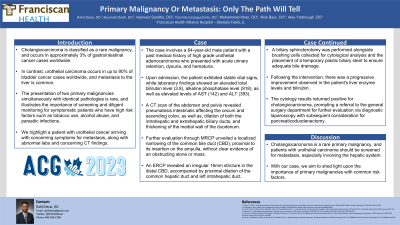Monday Poster Session
Category: Biliary/Pancreas
P1561 - Primary Malignancy or Metastasis? Only the Path Will Tell
Monday, October 23, 2023
10:30 AM - 4:15 PM PT
Location: Exhibit Hall

Has Audio

Rahil Desai, DO
Franciscan Health Olympia Fields
Westlake, OH
Presenting Author(s)
Rahil Desai, DO1, Shyamal Sheth, DO2, Hasnoor Sandhu, DO2, Varshita Goduguchinta, DO3, Mohammed Khan, DO2, Nicholas Baur, DO3, Alex Yarbrough, DO2
1Franciscan Health Olympia Fields, Westlake, OH; 2Franciscan Health Olympia Fields, Olympia Fields, IL; 3Franciscan Health Olympia Fields, Chicago, IL
Introduction: Cholangiocarcinoma is classified as a rare malignancy, and occurs in approximately 3% of gastrointestinal cancer cases worldwide. In contrast, urothelial carcinoma occurs in up to 90% of bladder cancer cases worldwide, and metastasis to the liver is common. The presentation of two primary malignancies simultaneously with identical pathologies is rare, and illustrates the importance of screening and diligent monitoring for symptomatic patients who have high risk factors such as tobacco use, alcohol abuse, and parasitic infections. We highlight a patient with urothelial cancer arriving with concerning symptoms for metastasis, along with abnormal labs and concerning CT findings.
Case Description/Methods: The case involves a 64-year-old male patient with a past medical history of high grade urothelial adenocarcinoma who presented with acute urinary retention, dysuria, and hematuria. Upon admission, the patient exhibited stable vital signs, while laboratory findings showed an elevated total bilirubin level (3.8), alkaline phosphatase level (918), as well as elevated levels of AST (142) and ALT (393). A CT scan of the abdomen and pelvis revealed pneumatosis intestinalis affecting the cecum and ascending colon, as well as, dilation of both the intrahepatic and extrahepatic biliary ducts, and thickening of the medial wall of the duodenum. Further evaluation through MRCP unveiled a localized narrowing of the common bile duct (CBD), proximal to its insertion on the ampulla, without clear evidence of an obstructing stone or mass. An ERCP revealed an irregular 16mm stricture in the distal CBD, accompanied by proximal dilation of the common hepatic duct and left intrahepatic duct. A biliary sphincterotomy was performed alongside brushing cells collected for cytological analysis and the placement of a temporary plastic biliary stent to ensure adequate bile drainage. Following the intervention, there was a progressive improvement observed in the patient's liver enzyme levels and bilirubin. The cytology results returned positive for cholangiocarcinoma, prompting a referral to the general surgery department for further evaluation via diagnostic laparoscopy with subsequent consideration for pancreaticoduodenectomy.
Discussion: Cholangiocarcinoma is a rare primary malignancy, and patients with urothelial carcinoma should be screened for metastasis, especially involving the hepatic system. With our case, we aim to shed light upon the importance of primary malignancies with common risk factors.
Disclosures:
Rahil Desai, DO1, Shyamal Sheth, DO2, Hasnoor Sandhu, DO2, Varshita Goduguchinta, DO3, Mohammed Khan, DO2, Nicholas Baur, DO3, Alex Yarbrough, DO2. P1561 - Primary Malignancy or Metastasis? Only the Path Will Tell, ACG 2023 Annual Scientific Meeting Abstracts. Vancouver, BC, Canada: American College of Gastroenterology.
1Franciscan Health Olympia Fields, Westlake, OH; 2Franciscan Health Olympia Fields, Olympia Fields, IL; 3Franciscan Health Olympia Fields, Chicago, IL
Introduction: Cholangiocarcinoma is classified as a rare malignancy, and occurs in approximately 3% of gastrointestinal cancer cases worldwide. In contrast, urothelial carcinoma occurs in up to 90% of bladder cancer cases worldwide, and metastasis to the liver is common. The presentation of two primary malignancies simultaneously with identical pathologies is rare, and illustrates the importance of screening and diligent monitoring for symptomatic patients who have high risk factors such as tobacco use, alcohol abuse, and parasitic infections. We highlight a patient with urothelial cancer arriving with concerning symptoms for metastasis, along with abnormal labs and concerning CT findings.
Case Description/Methods: The case involves a 64-year-old male patient with a past medical history of high grade urothelial adenocarcinoma who presented with acute urinary retention, dysuria, and hematuria. Upon admission, the patient exhibited stable vital signs, while laboratory findings showed an elevated total bilirubin level (3.8), alkaline phosphatase level (918), as well as elevated levels of AST (142) and ALT (393). A CT scan of the abdomen and pelvis revealed pneumatosis intestinalis affecting the cecum and ascending colon, as well as, dilation of both the intrahepatic and extrahepatic biliary ducts, and thickening of the medial wall of the duodenum. Further evaluation through MRCP unveiled a localized narrowing of the common bile duct (CBD), proximal to its insertion on the ampulla, without clear evidence of an obstructing stone or mass. An ERCP revealed an irregular 16mm stricture in the distal CBD, accompanied by proximal dilation of the common hepatic duct and left intrahepatic duct. A biliary sphincterotomy was performed alongside brushing cells collected for cytological analysis and the placement of a temporary plastic biliary stent to ensure adequate bile drainage. Following the intervention, there was a progressive improvement observed in the patient's liver enzyme levels and bilirubin. The cytology results returned positive for cholangiocarcinoma, prompting a referral to the general surgery department for further evaluation via diagnostic laparoscopy with subsequent consideration for pancreaticoduodenectomy.
Discussion: Cholangiocarcinoma is a rare primary malignancy, and patients with urothelial carcinoma should be screened for metastasis, especially involving the hepatic system. With our case, we aim to shed light upon the importance of primary malignancies with common risk factors.
Disclosures:
Rahil Desai indicated no relevant financial relationships.
Shyamal Sheth indicated no relevant financial relationships.
Hasnoor Sandhu indicated no relevant financial relationships.
Varshita Goduguchinta indicated no relevant financial relationships.
Mohammed Khan indicated no relevant financial relationships.
Nicholas Baur indicated no relevant financial relationships.
Alex Yarbrough indicated no relevant financial relationships.
Rahil Desai, DO1, Shyamal Sheth, DO2, Hasnoor Sandhu, DO2, Varshita Goduguchinta, DO3, Mohammed Khan, DO2, Nicholas Baur, DO3, Alex Yarbrough, DO2. P1561 - Primary Malignancy or Metastasis? Only the Path Will Tell, ACG 2023 Annual Scientific Meeting Abstracts. Vancouver, BC, Canada: American College of Gastroenterology.
